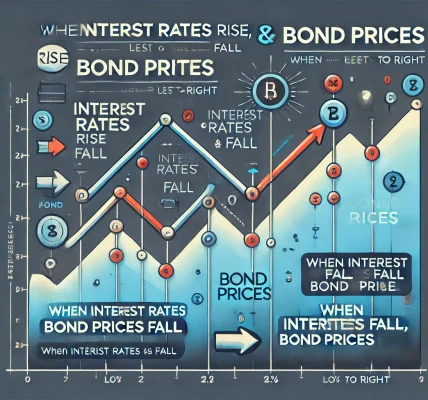As retirement approaches, investors prioritize safety, stability, and a predictable income stream. One proven strategy to achieve these goals is bond laddering. A bond ladder involves purchasing multiple bonds with staggered maturities, ensuring that a portion of the portfolio matures regularly. This strategy helps retirees mitigate interest rate risk, generate consistent income, and maintain liquidity.
This comprehensive guide explores the concept of bond laddering for retirement planning, its benefits, potential risks, and practical steps to build an effective bond ladder.
📚 What is a Bond Ladder?
📈 Definition
A bond ladder is a portfolio of bonds with different maturity dates. Instead of investing in a single bond or bonds with similar durations, investors buy bonds that mature at regular intervals, providing a steady stream of income.
✅ Example:
An investor purchases bonds with maturities of 1, 3, 5, 7, and 10 years. When the 1-year bond matures, the proceeds can be reinvested in a new 10-year bond, maintaining the ladder structure.
🎯 Why Bond Laddering is Ideal for Retirement Planning
Retirement brings a shift in financial priorities from wealth accumulation to wealth preservation and income generation. Bond ladders align perfectly with these objectives by ensuring predictable income while reducing exposure to interest rate fluctuations.
💡 How It Works
- Divide Capital: Allocate funds across bonds with staggered maturities.
- Receive Regular Income: As each bond matures, it generates principal and interest, providing periodic cash flow.
- Reinvest or Withdraw: Reinvest proceeds into new bonds or withdraw as needed, depending on market conditions.
📊 Benefits of Bond Laddering for Retirement Planning
💰 1. Predictable and Steady Income
Bonds provide fixed interest payments (coupon payments), ensuring a reliable income stream. As each bond matures, it can be reinvested or used to meet retirement expenses.
✅ Example:
A retiree can use bond maturity proceeds to cover living expenses, ensuring a stable cash flow.
📉 2. Mitigation of Interest Rate Risk
Bond ladders reduce exposure to interest rate fluctuations. Since bonds mature at regular intervals, investors can reinvest at prevailing interest rates.
✅ Example:
If interest rates rise, proceeds from maturing bonds can be reinvested in higher-yield bonds, protecting against falling returns.
🧾 3. Preservation of Capital
High-quality bonds, such as government or investment-grade corporate bonds, help preserve capital, a key goal for retirees.
✅ Example:
Matured bond proceeds can be reinvested in similarly safe instruments to maintain the portfolio’s stability.
🔄 4. Flexibility and Liquidity
As bonds mature periodically, investors have the flexibility to adjust their investment strategy based on changing financial needs or market conditions.
✅ Example:
A retiree may choose to reinvest, withdraw, or diversify proceeds depending on their financial goals.
📈 5. Protection Against Inflation (With TIPS)
Incorporating Treasury Inflation-Protected Securities (TIPS) into a bond ladder protects against inflation, preserving purchasing power over time.
✅ Example:
TIPS adjust principal value based on inflation, ensuring real returns for retirees.
📉 Potential Risks of Bond Laddering
🌐 1. Reinvestment Risk
When a bond matures during a low-interest-rate environment, reinvesting the proceeds may yield lower returns.
⚠️ Mitigation:
Consider diversifying with bonds of varying maturities or allocating some funds to higher-yielding securities.
📊 2. Inflation Risk (For Fixed-Rate Bonds)
Fixed-rate bonds may lose purchasing power over time if inflation outpaces returns.
⚠️ Mitigation:
Include TIPS or inflation-linked bonds to hedge against inflation.
🔄 3. Credit Risk
Corporate bonds carry the risk of default, especially during economic downturns.
⚠️ Mitigation:
Stick to high-quality, investment-grade bonds to minimize default risk.
📉 4. Opportunity Cost
A bond ladder may limit exposure to higher-yielding investment opportunities.
⚠️ Mitigation:
Maintain a diversified portfolio with a mix of asset classes.
📚 How to Build a Bond Ladder for Retirement
📊 Step 1: Determine Investment Goals and Timeline
Evaluate retirement income needs, time horizon, and risk tolerance.
✅ Tip:
Estimate annual living expenses and match bond maturities with anticipated withdrawals.
💡 Step 2: Choose Bond Types
Select high-quality bonds that align with retirement objectives.
📚 Popular Options:
- Treasury Bonds: Low-risk, backed by the government.
- Municipal Bonds: Tax-exempt income for residents of the issuing state.
- Corporate Bonds: Higher yields but with increased credit risk.
- TIPS: Protection against inflation.
📈 Step 3: Define Maturity Intervals
Spread bond maturities across 1, 3, 5, 7, and 10 years (or longer), ensuring consistent cash flow.
✅ Tip:
Ladders with 5-10 years provide a good balance between income stability and flexibility.
🔄 Step 4: Allocate Capital Across Bonds
Divide your investment across bonds with staggered maturity dates to maintain liquidity and minimize reinvestment risk.
✅ Example:
Invest ₹10,00,000 equally across 5 bonds with different maturity dates.
📉 Step 5: Monitor and Rebalance Periodically
Review the ladder periodically, reinvest matured proceeds, and adjust allocations as necessary.
✅ Tip:
Evaluate bond yields and credit quality to optimize returns.
🔎 Example of a 5-Year Bond Ladder for Retirement
| Bond Type | Maturity | Investment Amount | Coupon Rate | Expected Return |
|---|---|---|---|---|
| Treasury Bond | 1 Year | ₹2,00,000 | 4% | ₹8,000 |
| Corporate Bond | 3 Years | ₹2,00,000 | 5% | ₹10,000 |
| Municipal Bond | 5 Years | ₹2,00,000 | 3.5% | ₹7,000 |
| TIPS | 7 Years | ₹2,00,000 | Inflation-Linked | ₹Varies |
| Treasury Bond | 10 Years | ₹2,00,000 | 4.5% | ₹9,000 |
🎯 Strategies to Optimize Bond Ladders for Retirement
📊 1. Combine Different Bond Types
Diversify with a mix of government, municipal, corporate bonds, and TIPS to optimize returns and reduce risk.
✅ Tip:
A well-balanced ladder includes a mix of taxable and tax-exempt bonds.
🔄 2. Reinvest Maturing Proceeds Strategically
When bonds mature, reinvest proceeds based on current market conditions and interest rates.
✅ Tip:
Consider extending the ladder to maintain a consistent income stream.
📉 3. Include Inflation-Protected Securities
Incorporate TIPS or inflation-linked bonds to safeguard against inflation risk.
✅ Tip:
Allocate at least 20-30% of the ladder to inflation-protected securities.
🧾 4. Adjust the Ladder Periodically
Reevaluate bond maturities and rebalance as retirement needs change.
✅ Tip:
Review the ladder annually to ensure alignment with financial goals.
🔎 Best Practices for Managing Bond Ladders in Retirement
📊 1. Maintain a Balance Between Growth and Security
Blend high-quality bonds with modest exposure to higher-yielding assets.
✅ Tip:
Include bonds with different credit ratings to balance risk and return.
📈 2. Monitor Market Conditions Regularly
Track changes in interest rates, inflation, and bond market trends to make informed decisions.
✅ Tip:
Adjust the ladder in response to changing market dynamics.
🔄 3. Use Professional Management for Large Portfolios
For larger portfolios, consider professional management to optimize bond selection and maturity intervals.
✅ Tip:
Engage a financial advisor specializing in fixed-income securities.
📝 Conclusion: Why Bond Ladders Are Ideal for Retirement Planning
Bond ladders provide a reliable and structured approach to generating predictable income during retirement. By diversifying maturities, types of bonds, and adjusting to market conditions, retirees can mitigate risks, maintain capital, and ensure consistent cash flow.
A well-constructed bond ladder aligns with retirement goals, ensuring that investors have the income stability they need to enjoy their golden years without financial stress.



